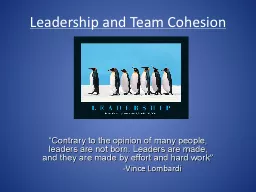

Contrary to the opinion of many people leaders are not born Leaders are made and they are made by effort and hard work Vince Lombardi Leadership Leadership the behavioural psychological and social process of influencing individuals to move toward the achievement of specific ID: 357139
Download Presentation The PPT/PDF document "Leadership and Team Cohesion" is the property of its rightful owner. Permission is granted to download and print the materials on this web site for personal, non-commercial use only, and to display it on your personal computer provided you do not modify the materials and that you retain all copyright notices contained in the materials. By downloading content from our website, you accept the terms of this agreement.
Slide1
Leadership and Team Cohesion
“Contrary to the opinion of many people, leaders are not born. Leaders are made, and they are made by effort and hard work” -Vince LombardiSlide2
Leadership
Leadership“the behavioural, psychological, and social process of influencing individuals to move toward the achievement of specific objectives”Behaviour aspect – commonly understood we recognize leaders because they act like leadersSocial Aspect –
leaders create a social environment
Social environments allow individuals to thrive in their pursuit of
team goals
Psychological Aspect
–
Least understood
has to do with personal charisma, and how leaders get people to do what they want them to doSlide3
Mental Aspects of Sport
Arousal- the state in which an athlete feels ready both psychologically and physically to do his/ her very best in competition, a mind- body relationship. Extreme arousal can impede physical and mental pathways, leading to poor performance because over excitement or out of control state of mind.Slide4
Mental Aspects of Sport- Anxiety
Anxiety: feelings of tension or nervousness that accompany preparation for or preparation in an athletic event. Relaxation: the mind-body state in which an athlete has no feelings of anxiety, and is feeling ready to do his/ her best. Often overanxious athletes relax the mind and body to the point where they are compete effectively. Slide5
Mental Aspects of Sport- Anxiety
Concentration: the ability to keep ones focus on the task at hand without being distracted from it by changes in the surrounding environment. An important factor is that environment changes constantly during competition and athlete needs to change frequently and rapidly. Athletes are often required to sort out, which external info (i.e., self- doubt) or cues relevant to performance and which are irrelevant. Motivation: the direction and intensity of effort.direction of effort refers to the tendency of a person to be attracted to certain sport situations.The intensity of ones efforts is a measure of how much actual physical and mental energy one is willing to put into an Endeavour. Slide6
Role of the Audience
Many athletes react positively to large crowds and the encouragement they can provide. Others seem to succeed better in settings where they are relatively isolated from spectators. Still others can become extremely discouraged or distracted by crowd noise. Sport psychologists work with athletes to help them to control their response to an audience and limit its impact on performance. Slide7
Factors Affecting Performance
Psychological skills training: the interaction between sport and psychology in which sport psychologists and athletes use specific tools to improve athletic performance. Self- talk, Imagery/ visualization, relaxation/ arousal regulation, setting goals. Slide8
Self-Talk
The internal monologue that goes through one’s mind, exhorting oneself to achieve success. One of the major tasks of a sport psychology is to teach athletes how to regulate and control this internal talk in a positive way and how to use it to achieve peak performance by enabling relaxation and optimal direction of intensity and effort. Slide9
Imagery/ Visualization
The process by which sport psychologists work with athletes to help them visualize or imagine themselves succeeding- almost like writing their own movie script, with them in the starring role- or to recall powerful images of past triumphs, all as ways of improving future performance.Psychologists often ask athletes to visualize scenarios that are completely unrelated to sport situations as a way of achieving certain mental states. Only works for those who actually believe it’s a powerful tool for athletic enhancement.Slide10
Relaxation/ Arousal Regulation
Breathing control exercisesProgressive relaxation exercises (which teach athletes to relax specific muscle groups individually unconscious way)MeditationImagerySlide11
Setting Goals
SMART principle:Specific: able to be precisely definedMeasureable: able to be quantifiedAttainable: within an athletes limitationsRealistic: attainable within constraintsTimely: achievable within a set time frameSlide12
Team CohesionSlide13
The Big Five
TraitDescriptionOpennessBeing curios, original, open to new ideas
Conscientiousness
Being organized, systematic and achievement oriented.
Extraversion
Being outgoing, talkative and sociable
Agreeableness
Being affable, tolerant, sensitive, trusting
Neuroticism
Being anxious, irritable, temperamentalSlide14
Team Cohesion
Team cohesion the team’s ability to interact effectively in their pursuit of team goals and group satisfactionHigh team cohesion results in high team culture (formal and informal social and organizational systems within the team that influences R
esults
in
team building
(deliberate process or attempt to develop an effective team culture
htat
will nurture and support team cohesion Slide15
Task vs Social Cohesion
TASK COHESIONTeam’s ability to interact effectively to successfully achieve performance or task goalsSlide16
Task vs Social Cohesion
SOCIAL COHESIONThe team’s ability to get along interpersonally or sociallyThe focus is how people get along with each other as opposed to how well people work togetherImportant motivational need of athletes is to be accepted or belong to a group, so a certain amount of social cohesion is important to meet this needSlide17
Social CohesionSlide18
Cohesion
Research has shown that cohesive teams do perform better than less cohesive teamsCohesion is a more important factor in influencing performance in sport than any other type of team or groupBoth task and social cohesion are related to performance success in sportCoaches should be aware of both types of cohesion and should make the team environment more cohesive